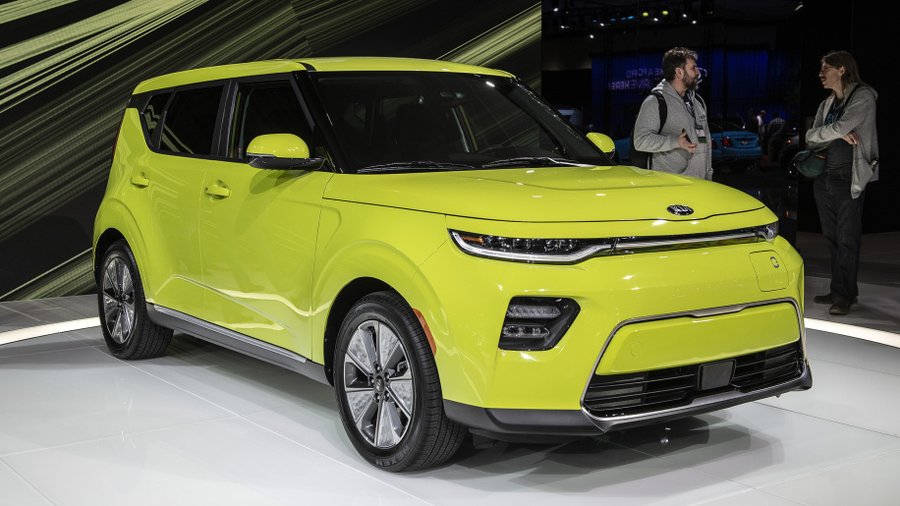The Kia Soul, the clear victor of the funky box fad of the mid-2000s, has been completely redesigned for the 2020 model year. It's still very square, but it's even funkier than before. The big, cute headlights of previous models have been swapped for a more futuristic, almost brooding set of slender lamps up top connected by a piece of plastic for a full-width look. They're supplemented by additional lights in large pods in the front bumper. There's a large grille in the bottom of the bumper, too. The overall nose is a bit more rounded, but the whole profile is about as upright as ever. The rear is completely vertical and retains vertical taillights that now have a wraparound look. The fenders don't visually protrude as much, but they're highlighted by deep creases around the wheel arches.
There are an array of trims to pick from on the new Soul, some of which have significant style tweaks. LX, S and EX make up the basic Soul, with an EX Designer Edition offering up two-tone paint between the roof and body as well as big 18-inch wheels. The Kia Soul Turbo is replaced by the Soul GT-Line, which can be had with the turbo engine or the naturally aspirated engine. It has a much more aggressive front fascia with extra slots around the grille and side sill extensions with red accents. The turbo version gets center-exit exhaust, bigger brakes and stiffer suspension. Then there's the new X-Line that gives the Soul a crossover look with plastic body cladding, fender flares and fog lights. It also has two-tone paint as an option.
Despite all the design changes, the new Soul is almost exactly the same size as the old one. It's just over 2 inches longer, and adds a little over an inch between the wheels, but width and height are the same. Passenger space is nearly the same, too, giving or taking a couple tenths of an inch here and there. There is much more cargo space now, though, picking up an extra 5 cubic feet for a total of 23.8. The restyled interior also gets some nice new features such as customizable ambient lighting, an available 10.25-inch touchscreen and a heads-up display.
There are three powertrains available for the Kia Soul, and only one is a carryover from the previous model. Starting at the bottom is the naturally aspirated 2.0-liter engine. This engine is also found in various other Hyundai and Kia products such as the Forte. It makes 147 horsepower and 132 pound-feet of torque. That's more than the current standard 1.6-liter engine's 130 horsepower and 118 pound-feet, but less than the current 2.0-liter engine's 161 horsepower and 150 pound-feet of torque. Though official numbers have yet to be released, it's safe to assume the new engine will be much more efficient, though, since the Forte with the new 2.0-liter engine manages between 37 and 41 mpg on the highway. The outgoing Soul in both 1.6-liter and 2.0-liter form top out at 30 mpg on the highway. This new 2.0-liter engine can be coupled either to Kia's new CVT or a six-speed manual transmission.
The turbocharged engine available on the Soul GT-Line is carryover from the current Turbo. It makes 201 horsepower and 195 pound-feet of torque. Manual transmission fans will be disappointed to hear that it still is only available with a seven-speed dual-clutch automatic transmission.
This all brings us to the Soul EV, which is now the hottest version of the little hatchback. It takes its electric motor and battery pack from the Niro EV and Kona Electric. That means it has 201 horsepower like the turbocharged model, but a whole lot more torque at 291 pound-feet. That's a huge increase over the 109 horsepower and 210 pound-feet of torque of the outgoing model. The battery is 64 kWh in capacity. Range hasn't been announced, but it should at least be over 200 miles, since the Kona Electric has a range of 258 miles with the same battery.
DC fast charging will be a standard feature, as will variable regenerative braking strength that's adjustable via steering wheel paddles. The Soul EV will also have four driving modes including Eco, Eco+, Comfort and Sport. Each mode adjusts motor output, regenerative braking, climate control settings and can implement speed limits.
The EV has a number of other unique qualities. It has its own special 17-inch alloy wheels and a front fascia with most of the lower grille closed off. Two versions are available, Soul EV, and Soul EV Designer Collection. The latter adds a few special two-tone paint schemes for the EV including grey with gold top, black with a red top and blue with a black top. The standard Soul EV is well-equipped with the 10.25-inch touchscreen as a standard feature across the board along with forward collision prevention, lane-keeping assist, adaptive cruise control with stop-and-go capability — though the EV Designer Collection ups the ante with a leatherette steering wheel and upholstery, 10-speaker audio system, heated seats and wireless phone charging.
The gas-powered Souls will go on sale in the first half of 2019. The Soul EV is more broadly targeted for sometime in 2019. Pricing for all models will come out close to the on-sale dates.
Related News

